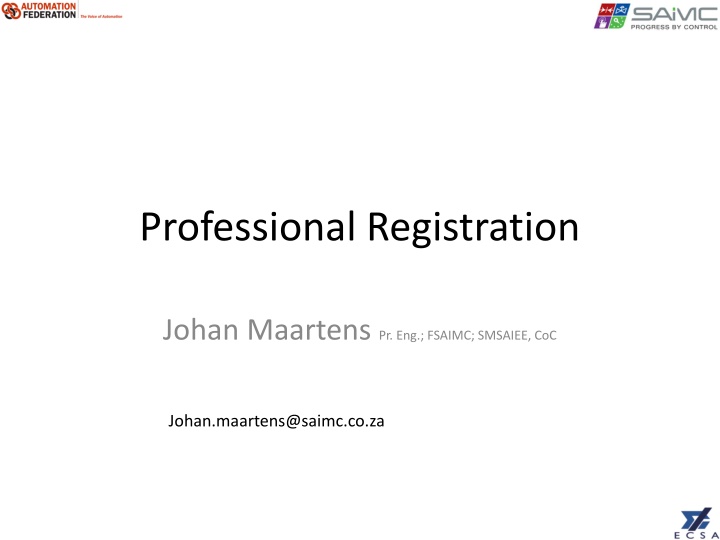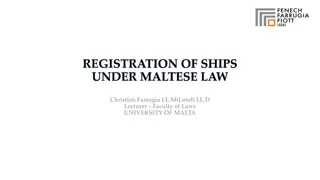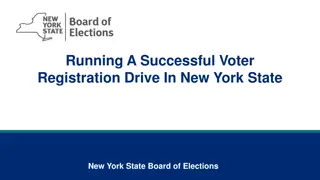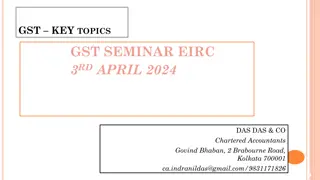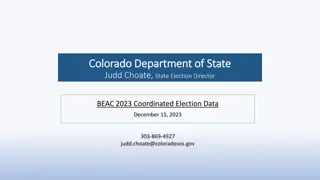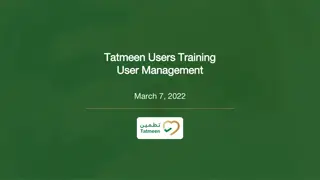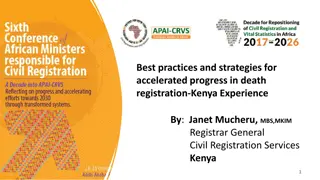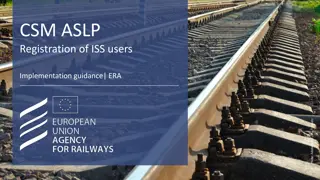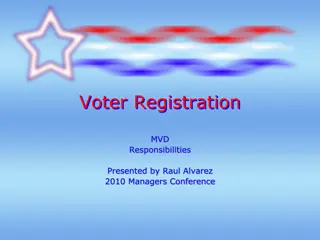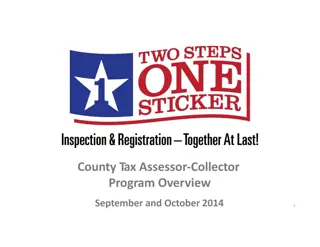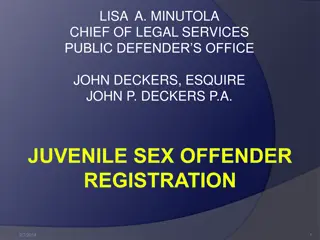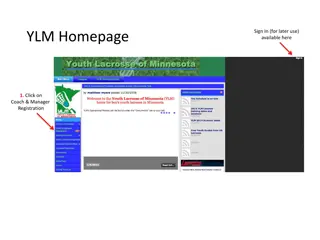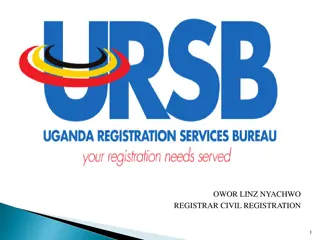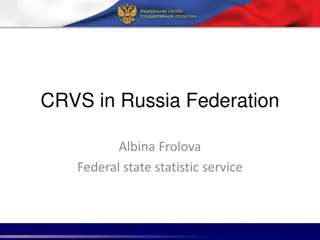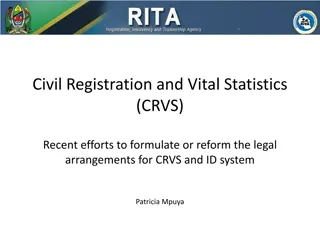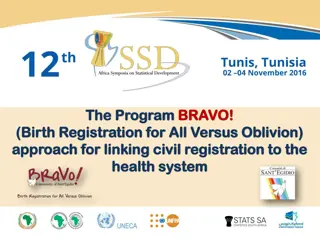Professional Registration
Delve into the requirements and implications of professional registration for engineers, discussing acts such as the CBE Act and the Engineering Professions Act. Understand the categories of registered persons, the identification of engineering work, and the core services in electrical and electronic engineering disciplines.
Download Presentation

Please find below an Image/Link to download the presentation.
The content on the website is provided AS IS for your information and personal use only. It may not be sold, licensed, or shared on other websites without obtaining consent from the author.If you encounter any issues during the download, it is possible that the publisher has removed the file from their server.
You are allowed to download the files provided on this website for personal or commercial use, subject to the condition that they are used lawfully. All files are the property of their respective owners.
The content on the website is provided AS IS for your information and personal use only. It may not be sold, licensed, or shared on other websites without obtaining consent from the author.
E N D
Presentation Transcript
Professional Registration Johan Maartens Pr. Eng.; FSAIMC; SMSAIEE, CoC Johan.maartens@saimc.co.za
Applicable Acts CBE Act 43 of 2000 Discuss qualifications, standards in education, training and competence, legislation impacting the built environment Determine policy with regard to the identification of work for the different categories of registered persons Engineering Professions Act 46 of 2000 18. (2) A person may not practise in any of the categories contemplated in subsection (1), unless he or she is registered in that category. (3) A person convicted of an offence in terms of section 18(2), may be liable to a fine equal to double the remuneration received by him or her for work done in contravention of section 18(2),
The Engineering Professions Act Eng. Prof. Act Identify Categories IoEW Electrical Chemical Engineer Technologist Technician
The IoEW Process Voluntary Associations Competition Commission ECSA SACBE DoL
Engineering Work: Electrical 10 (1) The core services in the electrical engineering discipline consist of the analysis, planning, design, manufacture, construction, management, operation and maintenance of materials, components, plant and systems for generating, transmitting, distributing and utilising - (a) electrical energy; (b) electronic devices, apparatus and control systems for industrial systems, bio-medical and consumer products and processes; and (c) computing, communication and software for critical applications instrumentation and control of processes, through the application of electrical, electromagnetic and information engineering sciences.
Electronic Engineering (b) advising on and designing electronic devices or components, circuits, semi-conductors and systems; (in Sales meetings notify customer your advise is not that of a registered professional) (c) specifying production or installation methods, materials and quality standards and directing production or installation work of electronic products and systems; (Beware of giving advise on how to use or install your products if you are not registered even if you know how) (d) supervising, controlling, developing and monitoring the operation and maintenance of electronic equipment and systems; (If you are involved in a project installing your equipment, make sure the contract does not require you to take any responsibility like Commissioning, SIAT or FAT if you are not registered) (e) establishing control standards and procedures to ensure efficient functioning and safety of electronic systems and equipment;
Electronic Engineering (f) organising and directing maintenance and repair of existing electronic systems and equipment; (g) designing electronic circuits and components for use in fields such as aeronautical guidance and propulsion control, acoustics or instruments and control; (h) determining manufacturing methods for electronic systems as well as the maintenance and repair of existing electronic systems and equipment; (j) designing and developing signal processing algorithms and implementing these through appropriate choice of hardware and software; (I) designing, specifying and implementing Control and Instrumentation of plant and processes; (m) designing, specifying, control and monitoring of equipment for fire and safety in plant and factories; (n) robotics and process control of manufacturing plant;
Transitional Provisions 27 (1) Any person who is not registered in terms of the Engineering Profession Act, and who is required to be registered as a professional or in a specified category in terms of this Notice must, within 36 months of the date on which this Notice comes into operation, apply for registration according to the programme contemplated in sub-item
Transitional Provisions (2) A person who is required to be registered in terms of this Notice and whose surname - (a) begins with the letter "A" to "K", may apply for registration from 1 January ????; (b) begins with the letter "L" to "Q", may apply for registration from 1 January ????; and (c) begins with the letter "R" to "l", may apply for registration from 1 January ????
Transitional Provisions (3) Any person whose registration in a category referred to in section 18(1)(a) or (c) was cancelled in terms of the Engineering Profession Act within one year prior to the date on which this Notice commences, must be re-registered in the appropriate professional category within six months from the date on which this Notice commences, unless he or she is not required to be so registered in terms of this Notice.
Category Differentiation Engineering Problem Complex (Engineer) Broadly Defined (Technologist) Well Defined (Technician) Specifically Defined (Government Certificate) Engineering Activity Complex (Engineer) Broadly Defined (Technologist) Well Defined (Technician) Specifically Defined (Government Certificate)
9 Competency Areas - Technician 1. Define, investigate and analyse well defined engineering problems. 2. Design or develop solutions to well defined engineering problems 3. Comprehend and apply advanced knowledge: principles, specialist knowledge, jurisdictional and local knowledge. 4. Manage part or all of one or more well defined engineering activities. 5. Communicate clearly with others in the course of his or her engineering activities
9 Competency Areas - Technician 6. Recognise and address the reasonably foreseeable social, cultural and environmental effects of well defined engineering activities. 7. Meet all legal and regulatory requirements and protect the health and safety of persons in the course of his or her well defined engineering activities 8. Conduct engineering activities ethically. 9. Exercise sound judgement in the course of well defined engineering activities.
Competency Areas (a) Define, investigate and analyse engineering problems; (b) design or develop solutions to engineering problems; (c) comprehend and apply engineering, technological, technical and specific knowledge in the practice area; (d) manage part or all of one or more engineering activities; (e) communicate clearly with others in the course of the engineering activity; (f) recognise and address, if applicable, the foreseeable social, cultural and environmental impact of engineering activities generally; (g) meet all legal and regulatory requirements and protect the health and safety of persons in the course of his or her engineering activity; (h) conduct engineering activities ethically; (i) exercise sound judgement in the course of engineering activities; j) be responsible for making decisions on part or all of one or more engineering activities; and (k) undertake professional development or independent learning activities sufficient to maintain and extend his or her competence.
CBE Act 43 of 2000 section 3 Objects of (CBE) council (a) Promote and protect the interests of the public in the built environment (h) Serve as a forum to discuss qualifications, standards in education, training and competence, legislation impacting the built environment
CBE Act 43 of 2000 section 4 (q) Functions, powers and duties of council: The council may liaise with the Competition Commission, established in terms of the 45 Competition Act, 1998 (Act No. 89 of 1998), on behalf of the councils for the professions regarding the identification of work for the built environment professions;
CBE Act 43 of 2000 section 20 Identification of work (1) The council must, after receipt of the recommendations of the councils for the professions submitted to it in terms of the professions Acts, and before liaising with the Competition Commission in terms of section 4(q) (a) determine policy with regard to the identification of work for the different categories of registered persons; (b) consult with any person, body or industry that may be affected by the identification of work in terms of this section. (2) The council must, after consultation with the Competition Commission, and in consultation with the councils for the professions, identify the scope of work for every category of registered persons.
Engineering Professions Act 46 of 2000 18. (1) The categories in which a person may register in the engineering profession are (a) professional, which is divided into (i) Professional Engineer; (ii) Professional Engineering Technologist; (iii) Professional Certificated Engineer; or (iv) Professional Engineering Technician; or (b) candidate, which is divided into (i) Candidate Engineer; (ii) Candidate Engineering Technologist; (iii) Candidate Certificated Engineer; or (iv) Candidate Engineering Technician; or (c) Specified categories prescribed by the council.
Engineering Professions Act 46 of 2000 18. (2) A person may not practise in any of the categories contemplated in subsection (1), unless he or she is registered in that category. (3) A person may practise in a consulting capacity in the category in which he or she is registered. (4) A person who is registered in the category of candidate must perform work in the engineering profession only under the supervision and control of a professional of a category as prescribed.
Engineering Professions Act 46 of 2000 41. (1) A person contravening section 18(2), 23, 25(8) or 31(8)(a), (b), (e) or (f), is guilty of an offence. (3) A person convicted of an offence in terms of section 18(2), may be liable to a fine equal to double the remuneration received by him or her for work done in contravention of section 18(2), or to a fine equal to the fine calculated according to the ratio determined for three years imprisonment in terms of the Adjustment of Fines Act, 1991.
